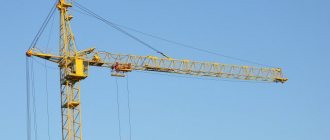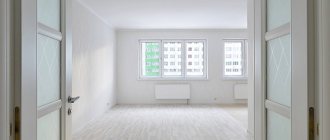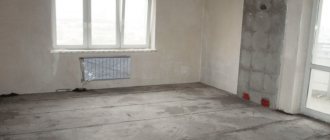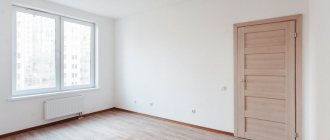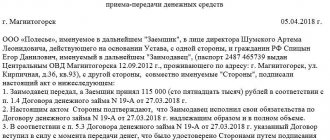An apartment in the eyes of the older generation is something unattainable. Which cannot be bought, but can only be received from the state in exchange for work for the benefit of the Motherland. Now times have changed, and the housing problem has become even stronger. Since the population has doubled over the past 50 years, and the housing stock has only become dilapidated. Construction of new housing is only taking place in large Russian cities, while small villages continue to lose permanent residents. Those who go to work and for a better life in regional cities. And having gained strength there and strengthened financially, they transport children to metropolises of regional significance. Where the construction of new housing is actively underway and children have the opportunity to get an education and then earn their own housing.
Signs and conditions for recognizing a premises as an apartment
From this definition, which may vary depending on the legislative acts of the region, we can draw conclusions about the main features of the apartment as such:
- structural isolation is the separation of apartment premises from other parts of the building by walls and a blocked entrance;
- functional connectivity - premises inside the apartment can be used for living and meeting household needs, while access to them is possible through a single entrance;
- compliance with sanitary and other standards governing composition, area, lighting, air exchange, water supply, energy, communication and wastewater disposal systems, general and fire safety;
- constructive connection with the building - the apartment is part of the house, it physically cannot be separated and moved.
A prerequisite for recognizing a premises as an apartment is the location of the house (building) on lands allocated for residential use and construction. If one of the listed conditions is not met, then the object becomes non-residential. An example of such a solution is apartments, which may have sufficient functionality for temporary residence (accommodation), but are not recognized as residential properties.
What you need to know about the “Residential” status
Article 16 of the Housing Code of the Russian Federation classifies a residential building and its part, an apartment (or part of an apartment), and a room as residential premises. Article 15 gives a more detailed definition of “residential premises” - this is the name of a property that is isolated and suitable for permanent residence.
Such real estate must meet certain sanitary standards and legal requirements. In some cases, regulatory authorities may recognize that the premises are unfit for habitation.
In fact, the concept of living space is quite broad. Although an apartment is one of its varieties. The status of “residential premises” also includes residential buildings, rooms, parts of rooms, parts of houses.
Residential, apartment and block buildings
However, there is one more subtlety - this is the concept of an apartment building, which we will talk about separately, since it remains the subject of controversy and, in addition to urban planning and design features, has some features in terms of ownership. Most apartments in new buildings are sold in multi-apartment buildings. But there is also blocked (block) development. The difference lies in the ownership of the part of the land directly associated with this building, which is commonly called a townhouse.
How do these legal statuses differ?
Not very honest realtors or managers of development companies can assure that there is no difference between an apartment and a residential premises as real estate statuses. In reality, the key difference lies in the documents for the land on which the house stands, as well as the status of the house as a whole.
Houses with full-fledged apartments are built on plots of land that, according to documents, are intended specifically for the construction of a multi-apartment residential building. Houses with “living premises” are built on land with a completely different purpose - for individual residential construction.
Accordingly, the status of the house itself is different. In the first case, it is a “multi-apartment residential building”. In the second - “individual residential building”.
Technical passport for the apartment
Each apartment has its boundaries. They are reflected in the floor plan and technical passport for the premises.
In the same document you can also see red lines indicating that some wall, air duct, linen closet or storage room in the apartment was demolished or moved. Or one of the rooms was attached to the kitchen. To transform an old-style apartment into a so-called European layout. With a large living room for receiving guests, combined with a kitchen. So that the housewife does not feel uncomfortable while cooking. At this time I could communicate with guests and family members at the same time.
A technical plan for an apartment is necessary to resolve disputes that arise in court. In order to establish the possibility of physical division of the apartment between former spouses. Who own half (½ share in an apartment) of an apartment, and there is a need to divide the entire apartment into 2 living spaces. Dedicated in nature in the form of isolated rooms.
Sometimes, based on the plan for the apartment. The court finds that it is physically impossible to carry out such a division. For example, in those apartments. Where adjacent rooms or spouses share equal shares in a one-room apartment, which does not involve splitting into two isolated rooms.
The technical plan also shows which of the walls is permanent and which can be moved. This is the reason for residents to carry out legal redevelopment in apartments located in the old housing stock. Which was built rather not from the point of view of comfort, but based on the size of the family.
Previously, according to the number of children and persons registered on one personal account. When moving in, they were given an apartment with the same number of rooms according to the number registered.
It was beneficial for people awaiting resettlement to register as many citizens as possible in order to receive 1 room for each registered resident upon resettlement. Having no other housing.
Therefore, the rooms in the apartments were built small and there were even those where an adult double bed could hardly fit. The area of sleeping rooms in apartments of old construction varied on average from 6 to 10 m2.
At the same time, a room with an area of 10 m2 was considered a very spacious home. Such a luxurious room in a large family was given to a newly formed young couple. Which, after 5-6 years of intensive reproduction, populated this room with two or three children born during this time. To have the opportunity to also get on the waiting list as a low-income person. And this continued ad infinitum for several decades, and several generations of people grew up in such conditions. Those who considered the communal apartment their home and could not even imagine another life.
Having bought such an apartment in an old building with small rooms, the new owner needs to go to the BTI (technical inventory bureau). And get an apartment passport there, from which it will be clear which walls are not permanent and can be demolished during legal redevelopment.
Then, you need to double-check your decision by contacting an organization specializing in redevelopment, and find out whether it is realistic to obtain permission before starting redevelopment work. And will such redevelopment be legalized in the future?
Why do you need to know the living area of your apartment?
The parameter is so important because it really serves as a key characteristic of a private house or apartment. For example, it is known that the total area of a one-room apartment is 35 square meters. It would seem not bad. But if there are only 10 living rooms, you will inevitably wonder whether you need housing with such a cramped room given the square footage for which you have to regularly pay for utilities, or whether you should look for an option with a more optimal ratio?
What’s interesting is that everything not included in the living area did not receive any separate designation. Usually residential and common areas are mentioned, and the kitchen is mentioned separately. It's simple. The remaining parameters simply do not have such fundamental importance, so they were not awarded a separate general mention.
Do the apartments have any disadvantages?
Yes, there are indeed a number of disadvantages.
When talking about the difference between an apartment and an apartment, it is necessary to list these negative points:
- Since they are considered non-residential, you cannot register in them or make long-term registration at your place of residence. It turns out that the owners of the apartments will not be able to register, for example, at the labor exchange. Developers do not undertake any obligation to provide a social structure. It is for this reason that residents of such complexes are assigned to hospitals and schools after those who have permanent residence in the area. However, as practice shows, the majority of apartment buyers are not interested in the registration issue at all. As a rule, this is not their first property. As for hospitals, they use paid medicine, and children are taken to elite private educational institutions.
- High taxes. For an apartment, the tax rate is up to 0.3% of the cadastral value. And for apartments - up to two percent. But they are cheaper than apartments of similar size, so ultimately the tax base for them is less, which means the tax amount is also less.
- Higher cost of utility bills. All tariffs for electricity, gas and water in apartments are calculated as for non-residential buildings, and therefore they are higher than in ordinary apartments. The difference will be from ten to twenty-five percent. For owners of luxury housing, this is not a problem at all.
- Lack of any housing benefits. Since apartments are non-residential premises, naturally, the owners will not be able to take advantage of property deductions or other benefits. But if lawsuits arise, they will not be able to recover the apartments, even if this is the family’s only home. And finally, the law on subsidies does not apply to apartments.
We have looked at the main differences between an apartment and an apartment.
In general, the latter are a very profitable investment. For most of their owners, the advantages outweigh the disadvantages.
The Moscow government plans to regulate the apartment market. They want to equate luxury housing with apartments, and this will lead to higher prices.
Disadvantages of studio apartments
In our country, for some reason, a studio is considered something elite. In fact, this is a deep misconception. Let's start with the fact that such housing is convenient for only one or two people.
The advantages include good lighting with a minimum area. I'm glad to see the possibility of redevelopment. The area increases due to the absence of corridors. In the West, studios are popular because they are cheap. In our country, the refurbishment of premises is carried out according to an individual project, which is why it becomes very expensive. It's just not worth it. But the end result, at great expense, is housing that is not entirely convenient for the average family.
The studio option is used in large country houses to decorate the first floor, where the living room, kitchen and hall are made into a single space with zoning elements. The remaining floors have a regular layout, with separate rooms, corridors, etc. This option is certainly acceptable. However, not everyone can afford it.
Financial and personal account for an apartment
The financial and personal account for an apartment includes all available information about the citizens living in it and their degree of relationship. Depending on whether this apartment is the owner’s only home or whether he has other housing. The amount of accrued utility bills will also depend.
The benefit for utility bills for privileged categories of citizens also applies to only one of the apartments. And it is not necessary for a pensioner to be registered in it. The benefits can be applied to any apartment you own, even the one you own. Where the beneficiary is the owner without registration. Or he is registered, but does not personally reside.
The personal account also shows the area of the apartment and its address. Information about which of the people registered in the apartment are the owners. And who are simply registered persons not endowed with ownership rights to this apartment.
What title documents do the owners have, and how did they acquire ownership of the apartment? It was a paid share in a cooperative, an inheritance, a gift. Or the apartment was purchased under a purchase and sale agreement.
All information can be obtained by the owner when visiting a multifunctional center or one-stop service in the form of an extract from the FLS (financial and personal account).
Such FLS are managed by management organizations that generate monthly bills for the provided utility services.
For convenience, each apartment has its own cadastral number. Representing several numbers located one after another. Indicating the location of an apartment building. Information about the owner, floor and area of the property. Information about whether this object is a residential premises and the date the object was registered in the cadastral register or the latest changes were made.
Since the apartment could become communal and was divided into rooms. Each of which began to have its own separate cadastral number.
In this case, such an object as an “apartment” ceased to exist, and new real estate objects appeared in its place. Which are completely independent and each of them has its own separate cadastral number - isolated rooms.
A separate cadastral number allows the sale of rooms without notifying other owners in a communal apartment, as happens when selling a share in an apartment. Where the seller is first obliged to offer to buy his share to all his shareholders, notifying them of his intention to sell his share notarized and indicating the exact redemption price.
This happens because the apartment is in shares owned by several owners. So it remains one piece of real estate with one cadastral number. And in the extract from the FLS received by one of the owners, all other co-owners will be indicated. Who also own shares in this apartment.
An extract is obtained for transactions involving the purchase and sale of apartments. The extract is presented to the buyer by the seller as confirmation of the parameters that were originally stated in the advertisement for sale.
The extract also confirms ownership of the apartment and the absence of encumbrances imposed on the apartment by third parties (pledge, mortgage). As well as other restrictions imposed by the judicial authority. For example, a temporary restriction or a complete ban on the sale of a given apartment, in connection with the fact. That the apartment is the subject of security for the debt its owner has incurred to his ex-wife for alimony or debts of the existing business.
For more complete information on the apartment. Including all transfers of rights from the moment of ownership of the apartment and all the people who were registered there. You can order an extended extract for the apartment, which will give a comprehensive picture of the history of the apartment in terms of its criminal history.
It is possible to obtain an extract online through numerous websites on the Internet. You can also order any documents and many different extracts for all kinds of real estate (building, structure, land, apartment) and other documents directly on our website.
To do this, you need to go to the cadastral map section and enter the desired address of the property, or the cadastral number of the property in the search bar. Place an order for the document you need.
You will also find all prices and sample documents on the cadastral map page on the website. The time frame for receiving statements is from 2 hours to 3 days. It all depends on whether there are delays in the work of Rosreestr.
| Document | Price |
| Certificate of cadastral value | 219 rubles |
| Extract from the USRN about the object | 390 rubles |
| Extract from the Unified State Register of Real Estate on the transfer of rights | 390 rubles |
| Notification of no transfer of rights | 289 rubles |
| Urgent statement of transfer of rights | 989 rubles |
| Urgent statement about the object | 989 rubles |
| Subscribe to changes | 990 rubles |
To search for a property on the cadastral map online and order extracts, you can follow the link here
Attention!
The cost of an electronic statement received online on our website is
2 times cheaper than that. Which you will receive upon a personal visit to the MFC, although both of them are valid and accepted by any government bodies and in court.
